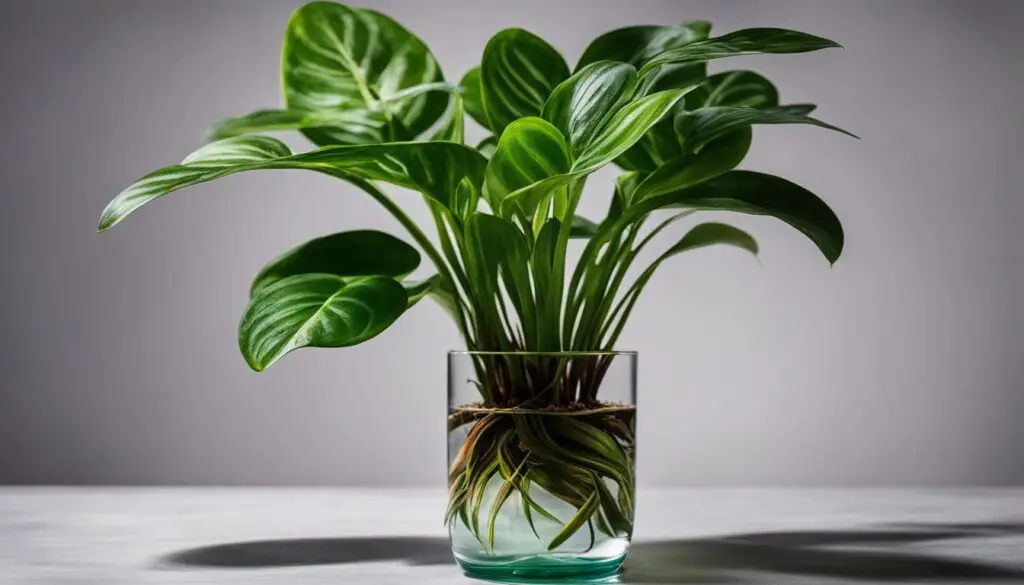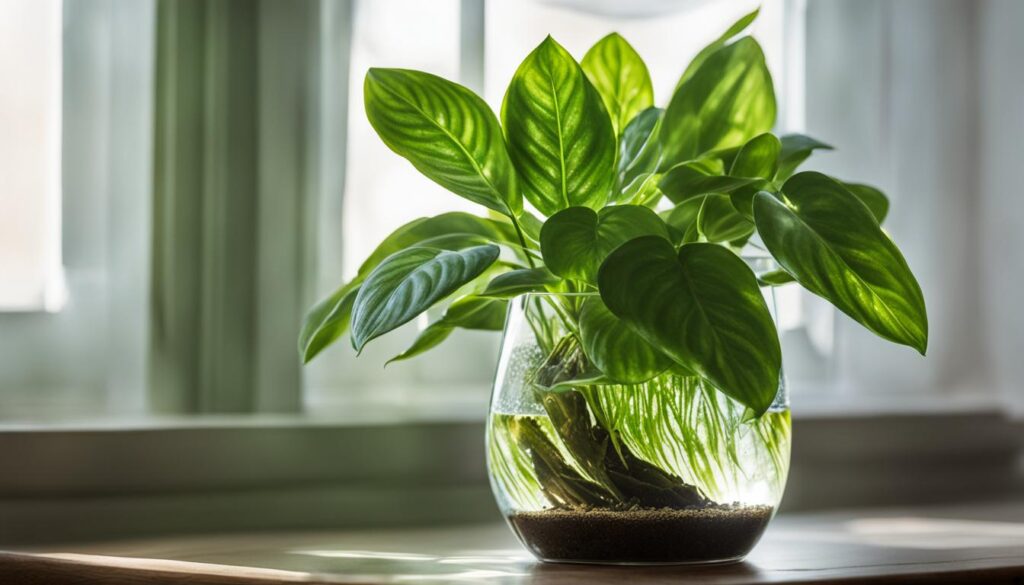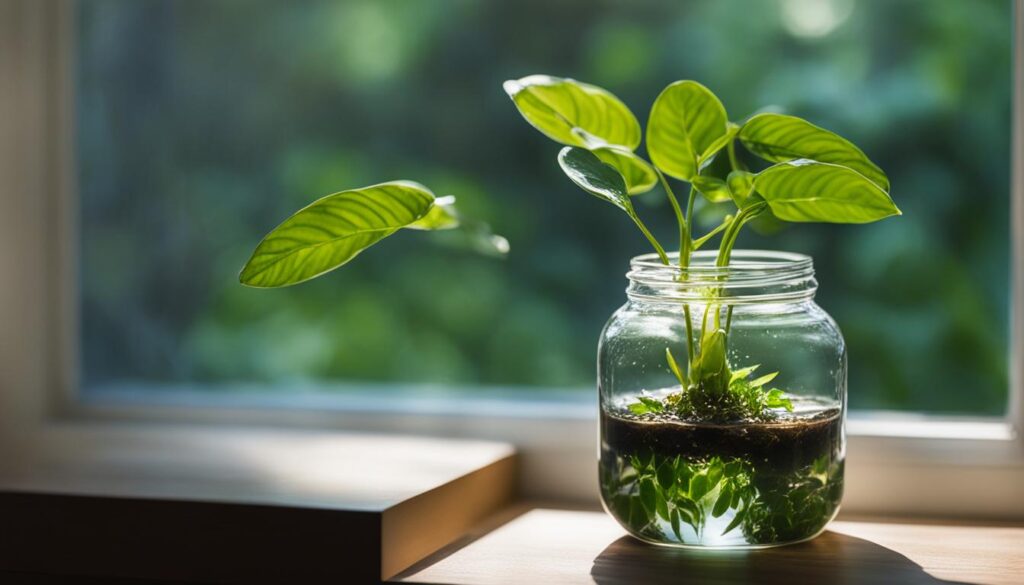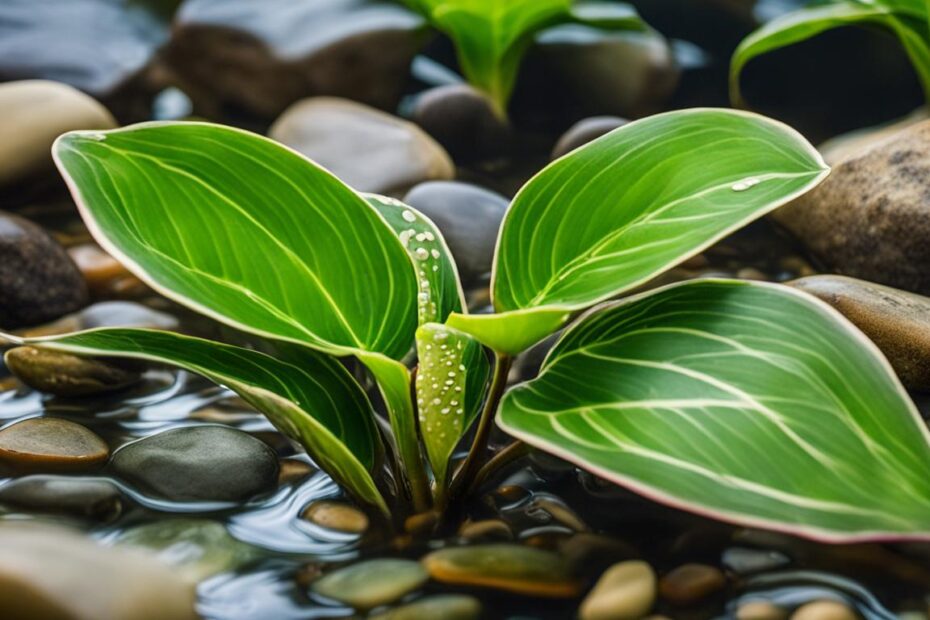Prayer Plants, scientifically known as Maranta leuconeura, are tropical plants native to Brazil. Many plant enthusiasts wonder if these beautiful foliage plants can live and thrive in water. In this article, we will explore the possibility of growing prayer plants in water, the benefits and challenges associated with water propagation, and the importance of soil for their overall health. Let’s dive in and find out whether prayer plants can truly flourish in water!
Key Takeaways:
- Prayer plants can survive temporarily in water, but they are not naturally adapted to this environment.
- Growing prayer plants in water can lead to nutrient deficiencies and hinder their overall growth and health.
- Water propagation for prayer plants is possible, but it does not provide optimal conditions for long-term growth.
- Proper soil provides the necessary nutrients, drainage, and moisture retention for prayer plants.
- Increased humidity is beneficial for prayer plants, but it does not compensate for the lack of nutrients in water.
The Potential of Water Propagation for Prayer Plants
Prayer Plants, like many other plants, can be propagated in water through a method known as water propagation. This process involves placing stem cuttings or divisions of the plant in water until roots develop. Water propagation is relatively easy and can be a successful way to propagate prayer plants, even for beginners.
However, it’s important to note that while prayer plants can live in water temporarily, they are not naturally adapted to this environment and won’t thrive in the long-term. Water lacks essential nutrients that are necessary for the plant’s optimal growth and health. Any nutrients present in the water get used up quickly, affecting the plant’s growth over time. Therefore, water propagation should be seen as a short-term solution rather than a permanent method of growing prayer plants.
Despite these limitations, there are some benefits to growing prayer plants in water. One advantage is that it allows for easier observation of the root growth process. Additionally, growing prayer plants in water can minimize the chances of soil-borne infections and provide an aesthetically pleasing display. However, to ensure the plant’s long-term health and vitality, it is recommended to transition the prayer plant to a well-draining soil medium that can provide the necessary nutrients and a more suitable growing environment.
The Challenges of Growing Prayer Plants in Water
While prayer plants can survive in water, growing them exclusively in this medium presents several challenges. The lack of essential nutrients in water can lead to stunted growth and nutrient deficiencies in prayer plants. It’s crucial to supplement the water with hydroponic fertilizers specifically formulated for plants grown in water. Testing the water and maintaining the proper nutrient balance is essential to prevent root damage. Additionally, changing the water every two to three weeks is recommended to ensure a fresh supply of nutrients and prevent the buildup of toxins or unpleasant odors. Despite the challenges, some plant enthusiasts find the aesthetics of prayer plants grown in water appealing.
One of the main challenges of growing prayer plants in water is the lack of nutrients. Water alone does not provide all the essential elements that prayer plants need for healthy growth. Nutrient deficiencies can manifest as yellowing or discolored leaves, poor root development, and overall reduced vigor. To ensure the plants receive the necessary nutrients, it’s important to provide hydroponic fertilizers specifically formulated for plants grown in water. These fertilizers contain a balanced blend of macronutrients and micronutrients that prayer plants require for optimal growth.
Another challenge is maintaining the proper nutrient balance in the water. Over time, the nutrients in the water can become depleted or imbalanced, affecting the plant’s health. Regular testing of the water’s pH and nutrient levels is essential to ensure the prayer plants are receiving adequate nutrition. Adjustments can be made by adding the appropriate fertilizers or changing the water if necessary. Care should be taken to avoid overfertilization, as this can lead to nutrient toxicity and harm the plants.
Changing the water every two to three weeks is recommended to ensure a fresh supply of nutrients and prevent the buildup of toxins and bacteria. Stagnant water can become a breeding ground for harmful microorganisms, leading to root rot and other infections. By regularly changing the water, prayer plants in a water-based system can maintain a healthier environment for root growth. It also helps eliminate any unpleasant odors that may develop in stagnant water, ensuring a more enjoyable growing experience.
| Challenges of Growing Prayer Plants in Water: |
|---|
| Lack of essential nutrients |
| Need for hydroponic fertilizers |
| Proper nutrient balance in water |
| Regular water changes |
The Importance of Soil for Prayer Plant Health
While prayer plants can survive in water, their optimal health and growth are achieved when planted in soil. Proper soil provides the necessary nutrients, drainage, and moisture retention that prayer plants require. Avoid overwatering the plant and ensure the soil is moist but not waterlogged. Well-draining soil is crucial for preventing root rot, which can be a common problem when growing prayer plants in water. Prayer plants also need indirect sunlight and high humidity to thrive, factors that are better regulated in soil rather than water.
When planted in soil, prayer plants have access to a rich source of nutrients that are essential for their growth and development. Soil provides the necessary organic matter and minerals that water alone cannot provide. The roots of prayer plants extract these nutrients from the soil, allowing the plant to thrive and produce healthy foliage.
In addition to nutrient availability, soil also plays a vital role in regulating moisture levels for prayer plants. Well-draining soil allows excess water to flow out of the pot, preventing waterlogged conditions that can lead to root rot. At the same time, it retains enough moisture to keep the soil consistently moist but not overly saturated. This balance is essential for the health and survival of prayer plants.
Table: Comparison of Soil and Water for Prayer Plant Growth
| Factors | Soil | Water |
|---|---|---|
| Nutrient Availability | Rich source of nutrients | Lacks essential nutrients |
| Moisture Regulation | Retains optimal moisture levels | Waterlogged conditions possible |
| Drainage | Allows excess water to flow out | No natural drainage |
| Root Health | Reduces the risk of root rot | Increased risk of root rot |
| Light and Humidity Regulation | Provides a suitable environment | May not regulate light and humidity |
Note: The table provides a comparison between soil and water for prayer plant growth. It highlights the advantages of soil in terms of nutrient availability, moisture regulation, drainage, root health, and light/humidity regulation.
Overall, while prayer plants can survive in water, their long-term health and growth are better supported in soil. Proper soil composition, moisture management, and nutrient availability play crucial roles in maintaining the vitality of prayer plants. While growing prayer plants in water can have its benefits, such as easier disease detection and aesthetic appeal, soil-based growth provides the optimal conditions for sustained growth and a thriving prayer plant.
The Benefits of Increased Humidity for Prayer Plants
Prayer plants, like Maranta species, thrive in high humidity environments. Increased humidity can greatly benefit the growth and health of these plants, even when they are grown in water. The natural leaf movement of prayer plants, known as nyctinasty, is influenced by changes in humidity and light. By increasing the humidity levels around the plant, either through water propagation or other methods, we can create an ideal environment for the prayer plant’s unique leaf movement.
One of the main benefits of increased humidity for prayer plants is the prevention of infections such as root rot. High humidity reduces the chance of the soil becoming overly saturated, which can lead to root rot and other fungal or bacterial infections. Additionally, growing prayer plants in water or in a closed glass jar can create a microclimate that mimics their native tropical habitat, providing the ideal conditions for growth and preventing the risk of diseases.
Another advantage of increased humidity is the promotion of healthy foliage. Prayer plants have vibrant and intricate leaves that are highly sensitive to changes in humidity. By maintaining a higher humidity level, the leaves of prayer plants remain more hydrated and less prone to drying out or becoming damaged. This results in healthier foliage and overall plant vigor.
| Benefits of Increased Humidity for Prayer Plants |
|---|
| Prevents infections such as root rot |
| Promotes healthy foliage |
| Creates an ideal environment for the unique leaf movement |
While increased humidity is beneficial for prayer plants, it is important to note that it does not compensate for the lack of nutrients in water for their long-term growth. While prayer plants can survive in water, they require proper nutrient supplementation to thrive. Therefore, it is essential to monitor the nutrient levels and provide balanced fertilization when growing prayer plants in water or any other medium.
Water Quality and Fertilization for Prayer Plants in Water
When growing prayer plants in water, it is important to consider the quality of the water and provide the necessary nutrients for their health and growth. Tap water often contains additives and minerals that can be detrimental to the plant’s roots. It is recommended to use distilled water to prevent any potential damage.
In addition to water quality, hydroponic fertilizers are essential for providing the required nutrients for prayer plants grown in water. These fertilizers are specifically designed for plants grown hydroponically and can be found in both liquid and solid forms. Testing the water regularly and following the fertilizer manufacturer’s instructions are critical for maintaining a balanced nutrient supply.

| Water Quality Tips for Growing Prayer Plants in Water | Fertilization Tips for Prayer Plants in Water |
|---|---|
|
|
Proper water quality and nutrient supply are essential for the successful growth of prayer plants in water. Ensuring the use of distilled water and hydroponic fertilizers can help prevent potential issues and provide the necessary elements for the plant’s health and vitality.
Disclaimer: The information provided in this section is for educational purposes only. It is not intended to be a substitute for professional guidance or advice. Always consult with a qualified horticulturist or plant expert before making any changes to your plant care routine.
The Challenges of Water Propagation and Growth in Prayer Plants
While water propagation can be initially successful for prayer plants, sustaining their growth in water can present several challenges. Prayer plants are not naturally adapted to aquatic environments, and over time, they may show signs of nutrient deficiencies, slower growth, and decreased overall vigor. Issues such as root rot, bacterial or fungal infections, and unstable nutrient levels can also arise when growing prayer plants exclusively in water. It is crucial to monitor the plant’s health, change the water regularly, and provide proper nutrient supplementation to mitigate these challenges.
One common problem that arises when growing prayer plants in water is the risk of root rot. When the roots are consistently submerged in water, they can become saturated and lack access to oxygen, leading to decay and eventual death of the plant. It is essential to maintain proper drainage and avoid overwatering to prevent this issue. Regularly changing the water every two to three weeks can also help prevent the buildup of toxins and maintain a fresh supply of nutrients.
Another challenge of growing prayer plants in water is the stabilization of nutrient levels. Unlike soil, which naturally contains essential nutrients for plant growth, water lacks these nutrients. While hydroponic fertilizers can be used to supplement the water, it is crucial to find the right balance to avoid nutrient deficiencies or nutrient excesses that can harm the plant. Regularly testing the water and following the fertilizer manufacturer’s instructions are essential for maintaining a balanced nutrient supply.
Growing Prayer Plants in Water: Is It Beneficial?

While prayer plants, also known as Maranta plants, are not naturally suited for long-term growth in water, some plant enthusiasts choose to grow them in this medium due to a variety of reasons. Growing prayer plants in water can offer certain benefits, such as easier detection of root infections and aesthetic appeal. However, there are also challenges to consider, including nutrient deficiencies and the need for proper care and attention to ensure the plant’s overall health and growth.
Benefits of Growing Prayer Plants in Water
One of the main benefits of growing prayer plants in water is the ability to easily detect and monitor root infections. When plants are grown in soil, it can be more challenging to identify and treat root-related issues. By growing prayer plants in water, the roots are exposed and visible, making it easier to spot any signs of infection or disease. Additionally, prayer plants grown in water can have a unique aesthetic appeal, adding a touch of greenery to any space.
“Growing prayer plants in water offers the benefit of observing the root growth process and can minimize the chances of soil-borne infections.”
However, it’s important to note that while these benefits exist, prayer plants are not naturally adapted to aquatic environments. They require specific care and attention to thrive in water, including the regular supplementation of nutrients and proper water quality. Without these considerations, prayer plants grown in water may experience stunted growth, nutrient deficiencies, and other issues that can affect their overall health and vigor.
Challenges of Growing Prayer Plants in Water
When growing prayer plants in water, one of the main challenges is the lack of essential nutrients. While water propagation can initially be successful, over time, the nutrients present in the water get used up quickly, resulting in nutrient deficiencies for the plant. This can lead to stunted growth, pale foliage, and a general decline in the plant’s health and vitality. To overcome this challenge, regular supplementation with hydroponic fertilizers specifically formulated for plants grown in water is necessary.
Additionally, changing the water every two to three weeks is recommended to prevent the buildup of toxins and ensure a fresh supply of nutrients. This can be time-consuming and requires a consistent commitment to maintain the plant’s health. Without proper care and attention, prayer plants grown exclusively in water may also be more susceptible to root rot and other bacterial or fungal infections.
| Pros and Cons of Growing Prayer Plants in Water | |
|---|---|
| Pros | Cons |
| Easy detection of root infections | Lack of essential nutrients |
| Aesthetic appeal | Potential for stunted growth |
| Risk of root rot and infections | |
Overall, while growing prayer plants in water can offer certain benefits, it’s essential to consider the challenges and limitations of this method. While it may be suitable for short-term observation or propagation purposes, providing a well-draining soil and proper care will lead to more robust growth and long-term success for prayer plants.
The Relationship Between Prayer Plants and Humidity
Prayer plants, including Maranta species, have a strong affinity for high humidity. The natural movement of their leaves, known as nyctinasty, is influenced by changes in humidity and light. Increased humidity can enhance the plant’s growth and overall health, allowing it to produce vibrant and healthy leaves. While growing prayer plants in water or using other methods to increase humidity can be beneficial, it’s important to consider other factors such as nutrient availability to ensure the plant’s long-term success.
One way to create a humid environment for prayer plants is by misting the leaves regularly. This helps to mimic the natural tropical conditions that these plants thrive in. Another method is to use a humidifier in the vicinity of the plant to maintain an optimal level of humidity. The use of pebble trays filled with water can also help increase humidity levels around the plant.
It’s important to note that while humidity is crucial for prayer plants, excessive moisture can lead to issues such as fungal infections and root rot. It’s essential to find a balance and monitor the plant closely to prevent these problems. Additionally, proper ventilation is important to prevent the buildup of stagnant air, which can also negatively affect the plant’s health.
| Humidity level | Recommended for Prayer Plants |
|---|---|
| 50-60% | Ideal for promoting healthy growth and leaf movement |
| 70-80% | Optimal for encouraging root development and overall plant vigor |
| Below 40% | Can lead to dry, wilting leaves and stunted growth |
Prayer plants’ inclination towards high humidity is a testament to their origins in the lush, tropical rainforests of Brazil. By providing the right moisture levels, we can recreate their natural habitat and ensure their well-being. However, it’s important to strike a balance and not to overdo it, as excessive humidity can create additional challenges for these plants.
Tips for Watering and Repotting Prayer Plants
Proper watering and repotting techniques are essential for the care and well-being of prayer plants grown in water. Here are some helpful tips to ensure your plants thrive:
- Monitor moisture levels: It’s important to keep the topsoil of your prayer plant moist but not overly saturated. Regularly check the moisture levels by inserting your finger into the soil. If it feels dry up to the first knuckle, it’s time to water. Avoid letting the soil dry out completely as this can stress the plant and hinder its growth.
- Regular watering: During the active growing season, which is typically spring and summer, prayer plants in water require regular watering. Aim to water them every 1-2 weeks or when the soil starts to feel slightly dry. Ensure the water thoroughly saturates the topsoil and drains out of the container.
- Choose the right pot: When repotting your prayer plant, select a container with proper drainage holes. This allows excess water to escape and prevents waterlogging, which can lead to root rot. Choose a pot size that allows for healthy root growth, but avoid overpotting as too much soil can retain excess moisture.
- Repot in spring: The best time to repot your prayer plant is in spring when it’s actively growing. Repotting during this period gives the plant a chance to adjust and recover more quickly. Avoid repotting during the dormant winter months as the plant’s growth is minimal at that time.
By following these care tips for watering and repotting, you’ll provide your prayer plants in water with the proper conditions they need to thrive and grow. Remember to monitor moisture levels, water regularly, choose the right pot, and repot during the appropriate time for optimal plant health.

Propagating Prayer Plants in Water
Water propagation is a popular method for propagating prayer plants, offering a simple and accessible way to expand your plant collection or revive struggling plants. There are two common methods for water propagation: stem cuttings and division.
Taking Stem Cuttings
To propagate prayer plants using stem cuttings, start by selecting a healthy, mature plant. Using clean, sharp scissors or pruning shears, cut a stem just below a leaf node. Remove any leaves from the lower portion of the stem, leaving only a few leaves at the top.
Place the stem cutting in a jar or vase filled with clean, room temperature water. Ensure that at least one or two leaf nodes are submerged in the water. Place the container in a bright location, but avoid direct sunlight that could scorch the plant. Change the water every few days to prevent the growth of bacteria or algae.
Over time, you will observe the development of roots from the submerged leaf nodes. Once the roots are a few inches long, you can transplant the cutting into a well-draining potting mix. Be careful not to damage the delicate roots when transferring the cutting. Continue to provide the proper care, including regular watering and indirect sunlight, to encourage healthy growth.

Dividing Prayer Plants
Another method of water propagation for prayer plants is division. This involves separating offsets or new growth from the parent plant and placing them directly in water or soil.
To divide a prayer plant, gently remove it from its pot, being careful not to damage the roots. Look for sections of the plant that have new growth or separate offsets. These can be carefully separated from the parent plant and placed in water.
Similar to stem cuttings, ensure that at least one or two leaf nodes are submerged in the water. Place the container in a well-lit area, away from direct sunlight. Change the water every few days to maintain its freshness.
Once the divided sections have developed a healthy root system, they can be transplanted into individual pots or transferred to soil. Provide the appropriate care and conditions to support their growth, including regular watering and indirect light.
Conclusion
While prayer plants can live and grow in water, it is important to note that this is not their natural environment. Growing prayer plants in water requires specific care and considerations to ensure their optimal health and growth. Water propagation can be a successful method for propagating new plants, but it is not a long-term solution for their overall well-being.
Prayer plants thrive when planted in well-draining soil, as it provides the necessary nutrients and moisture retention they need. While growing prayer plants in water may have some benefits such as easier disease detection and aesthetic appeal, it is vital to remember that soil-based growth offers the optimal conditions for long-term success.
Experimenting with alternative mediums like LECA (Lightweight Expanded Clay Aggregate) can provide a middle-ground option for prayer plant growth. LECA offers moisture regulation while reducing the risk of overwatering and root rot. However, it is essential to supplement with proper fertilization to ensure the plant’s health.
By understanding the specific needs of prayer plants and providing adequate care, you can ensure their vibrant growth and longevity. Whether you choose to grow them in water or soil, regular monitoring, proper watering, and maintaining nutrient balance are key to their overall well-being.
FAQ
Can prayer plants live in water?
While prayer plants can survive in water temporarily, they are not naturally adapted to this environment and won’t thrive in the long-term. They require moist, well-draining soil to thrive.
What is water propagation for prayer plants?
Water propagation is a method of growing prayer plants by placing stem cuttings or offsets in water until roots develop.
What are the benefits of growing prayer plants in water?
Growing prayer plants in water can offer easier detection of root infections and add aesthetic appeal to your plant collection. It also allows for observing the root growth process.
What are the challenges of growing prayer plants in water?
Water lacks essential nutrients for prayer plants, leading to stunted growth and nutrient deficiencies. Nutrients in the water also get used up quickly, affecting the plant’s growth over time.
Why is soil important for prayer plant health?
Soil provides the necessary nutrients, drainage, and moisture retention that prayer plants require for optimal growth. It also regulates factors like indirect sunlight and humidity more effectively than water.
What are the benefits of increased humidity for prayer plants?
Increased humidity around prayer plants creates a more favorable environment, mimicking their natural habitat. It reduces the risk of infections, such as root rot, and allows for healthier foliage and leaf movement.
What should I consider about water quality and fertilization for prayer plants in water?
Tap water may contain additives and minerals that can be harmful to prayer plant roots. It’s recommended to use distilled water and supplement it with hydroponic fertilizers specifically designed for plants grown in water.
What challenges can arise from water propagation and growth in prayer plants?
Prayer plants may show signs of nutrient deficiencies, slower growth, and decreased overall vigor when grown exclusively in water. Issues like root rot, infections, and unstable nutrient levels can also occur.
Are there alternative mediums for prayer plant growth?
LECA (Lightweight Expanded Clay Aggregate) is a clay-based medium that provides moisture retention and proper drainage. It can be a better option than water for long-term growth, although proper fertilization is still necessary.
What is the relationship between prayer plants and humidity?
Prayer plants thrive in high humidity. Growing them in water or using other methods to increase humidity can create a favorable environment, reducing the risk of infections and enhancing growth.
What are the tips for watering and repotting prayer plants in water?
Monitor the moisture levels, avoid overwatering, and ensure the topsoil does not dry out completely. Repotting should be done with caution, using pots with proper drainage and choosing an appropriate size.
How do I propagate prayer plants in water?
Prayer plants can be propagated in water through stem cuttings or division. Place stem cuttings in water until roots develop, or separate offsets from the parent plant and plant them directly in water or soil.








